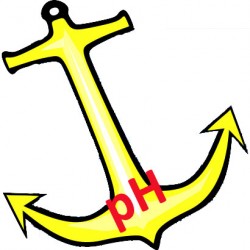There are several phrases and terms used to describe Total Alkalinity (TA):
- The buffering capacity of water
- Water’s ability to neutralize acid
- The pH stabilizer
- The ability of water to resist a change in pH
- A measure of the total of hydroxide ions (OH–), carbonate ions (CO3–) and bicarbonate ions (HCO3–) in water
- The pH anchor
These are all correct. As you know, TA is closely associated with pH (if TA goes up pH goes up; if TA goes down, pH goes down). But rather than being a measure of the hydrogen ion concentration in water, TA is a measure of the ability of water to neutralize hydrogen ions (acid). Measured in ppm, TA is the result of alkaline materials in the water (such as carbonates, bicarbonates, and hydroxides) and is made up mostly of bicarbonates. This acid neutralizing (buffering) capacity of water by TA is desirable because it helps prevent wide swings in pH whenever small amounts of acid or a base are added to the pool.
On page 36 of the IPSSA Basic Training Manual there is a chart that shows the pH change for different total alkalinity starting amounts. It shows that if one pint of acid is put in a 15,000 gallon pool, with the starting TA at 100 ppm and the starting pH at 7.5, the resulting pH will be 6.97. But if the starting TA is at 20 ppm in the same pool with the pH at the same 7.5, and the same pint of acid is added, the resulting pH will be 5.97 – that’s 10 TIMES MORE ACIDIC!
So the tech tip here is: measure your TA often and keep it in the correct operating range. Ideally your TA should be 80-120 ppm. If you have salt in the pool and you have a chlorine generator, it’s a good practice to keep the TA on the low side. Try to target 70-80 ppm, which will also help keep the pH down.
______________________________________________________________________
We had another great CPO certification class this past Thursday and Friday at PoolCorp’s SPP building in Anaheim. We had facility operators, managers, folks new to the industry and those 15+ year pool veterans who always have great contributions to class discussion — Thanks!–yours are the BEST! And thanks to all the SPP-Anaheim crew for hosting us again.


Comments
Great info, as always. I usually describe TA to my customers as the “amount of acid required to drop the pH to a predetermined level” – the higher the TA the more acid you’ll require, it’s the principle behind Taylor’s TA test.
Where can I grab (or purchase) the “IPSSA Basic Training Manual” ?
Thanks again, always a pleasure,
Paul
You can call us at 949-357-6160 and order one. They are $50.00 plus $5.00 shipping.
Thanks for the discussion on TA. What can we do, though, when TA movement does not correlate with pH movement? I have a pool that I maintain at 7.2 – 7.4 pH using acid, but the TA remains at 120+. What do you suggest? And I have another pool with the opposite problem: 7.2 – 7.4 pH, but TA at 20 – 40.
Thanks,
Jeff
They second pool you mention is the easy one — bring the TA up using bi-carb. The pH will rise also, but to a manageable level. The first pool, the one with the high TA, low pH is unusual. Check your TDS and calcium levels — one or both are probably high also and you may have to drain/dilute.
Steve,
I took the CPO certification class over a year ago. Your monthly news updates are as interesting as the original class was. The latest PH artical supports that walking the acid does nothing different than pouring but the 70 to 80 ppm TA in salt water totaly changes PH control.
Mike
pH generally does follow the TA — so keeping the TA on the low side in your salt pools will help bring down the pH. The notion that pouring the acid in one place (in a column) will change the TA more than walking the pour around the pool — is simply a myth. Check out this article by onBalance. And read the whole scientific research paper here.
Alkalinity at 70, pH at 8.2, what do I do to get pH down and alkalinity up?
Always adjust Alkalinity first. Use sodium bicarbonate to get your alkalinity up. With your pH already at 8.2, it will not change. Once the alkalinity is up, slowly bring the pH down — adding acid a little at a time over a few days.